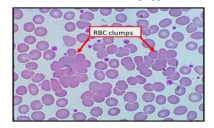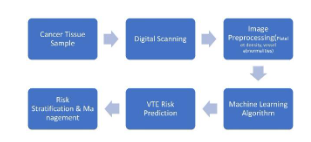Incidental synchronous appendicular neuroendocrine tumor in patient with right colonic adenocarcinoma: a case report
Presented in Emirates pathology, digital pathology Conference Holiday Inn Dubai, Al Barsha, UAE & Virtual
Speaker Name: Dr. Azza Aljaleeli
Category: Oral Presentation
Keywords: incidental, synchronous, appendix, right colon, case report
The abstract:
Neuroendocrine tumor (NET) is the most common tumors of the appendix which is usually found incidentally. Synchronous neuroendocrine tumor of the appendix and colonic carcinoma has been reported in previous case reports. The actual incidence of these synchronous tumors need to be determined by reviewing these case reports and the need to include appendectomy as part of oncological colorectal operations.
introduction:
Neuroendocrine tumors (NET) are found in different locations in the human body including the gastrointestinal tract [1]. In the appendix, they are the most common tumor which is usually found incidentally [2]. The incidence of these tumors is about 0.5% in the appendectomy specimens [3]. The patient with these tumors may present as acute appendicitis [4,5]. Appendicular NET located most often at the tip, usually as small lesion less than 1 cm [6].larger tumors more than 2 cm is associated with high risk of metastasis to the regional lymph nodes, liver or other sites[7]. Additionally, the prognosis of NET relates to the stage, the grade and whether the tumor is functioning or not [8].
Both the appendix and the colon have the same mucosal lining; thus, the same types of the tumors in the colon may affect the appendix, although with different frequencies [9,10]. It has been reported that 25% of the patients with appendicular tumor found to be synchronous or metachronous colon tumors [11].
In our case report, we describe asymptomatic neuroendocrine tumor of the appendix in patient with adenocarcinoma in the right colon.
Case presentation:
A Fifty-five year old female presented with chronic diarrhea more than 2years. Later on, the condition associated with colicky abdominal pain and weight loss about 5kg during the last 6months. Her blood investigations revealed normal values apart from mild anemia; the hemoglobin was 9.5gm/dl. Abdominal ultrasonography revealed right-sided bowel mass. Abdominal CT scan with contrast showed enhancing mass at the ascending colon with no evidence of distant metastasis, the mass cause intestinal obstruction.
Through midline incision, oncologic right hemicolectomy was done with side to side ilio-transverse colonic anastomosis. The postoperative period was uneventful and the patient discharge well after 5days.
The histopathological examination of right hemicolectomy revealed 5 cm, right colonic moderately differentiated adenocarcinoma with mucinous component invading the subserosal tissue (figure 1a, 1b). There were 35 lymph nodes detected grossly and they were tumor free microscopically. As a result, the tumor stage was considered (T3N0Mx). Additionally, there was a 4 mm well differentiated neuroendocrine tumor (carcinoid tumor), grade 1 at the tip of the appendix (figure2a, 2b, 2c).
Discussion:
Neuroendocrine tumor (carcinoid tumor), the most common neoplasm of the appendix, represents 80% of appendicular masses and has reported in 0.5% of appendectomy specimens [12].
Most cases are asymptomatic and discovered accidentally on pathological examination of the appendices removed for acute appendicitis or for other reasons; as a result, their diagnoses are difficult to establish preoperatively [13].
Regarding the treatment, appendectomy alone is considered curable in tumors less than 1 cm in size, while right hemicolectomy is indicated in tumors more than 2 cm or other high risk features like mesoappendiceal invasion. The management of tumors 1-2 cm in size is controversial [14,15] .
The prognosis of these tumors generally is good; however, The North American Neuroendocrine Society (NANETS) advise follow up every 3-6 months after the operation to exclude recurrent disease or lymph node metastasis [16].
Synchronous appendiceal NET and right sided colonic adenocarcinoma has been reported in a previous case report done by Yılmaz et al., who report two similar cases in his study [13].
Synchronous NET of appendix and other gastrointestinal tumors occur at a rate 55%. Additionally, different types of appendiceal tumors may be discovered accidentally in patients undergoing surgeries for their colorectal cancers in which their appendices were removed either as part of the specimens or separately.
In their study, Khan et al., found that the incidence rate of synchronous appendiceal tumor and colorectal cancer is 4.1% in 169 patients underwent incidental appendectomy as part of their operation [17].
The cost effectiveness of including appendectomy as part of colorectal cancer operations has been shown in a study done by Albright et al., who report no increase in the duration of operation for removing colorectal cancer when appendectomy was done and indicate that there are difficulties when appendectomy is considered in the future because of the previous abdominal surgery [18].
In addition to that, there was no increase in the incidence of infections postoperatively as indicated by some authors. Our case report indicates the need of considering appendectomy as part of oncological colorectal operations and the necessity of meticulous examination of the appendices removed to detect hidden primary or secondary appendiceal tumors.
References
[1] A.D. Domenico, T. Wiedmer, I. Marinoni, A. Perren, Genetic and Epigenetic Drivers of Neuroendocrine Tumours (NET) in: Endocrine-Related Cancer Volume 24 Issue 9 Year 2017, (2018, October 03) Retrieved from https://erc.bioscientifica.com/view/ A. Elkbuli, et al. Annals of Medicine and Surgery 43 (2019) 44–47 46 journals/erc/24/9/ERC-17-0012.xml.
[2] Y. Gu, N. Wang, H. Xu, Carcinoid tumor of the appendix: a case report, Oncol. Lett. 9 (5) (2015) 2401e2403.
[3] K.H. In’t Hof, H.C. van der Wal, G. Kazemier, et al., Carcinoid tumour of theappendix: an analysis of 1,485 consecutive emergency appendectomies, J.Gastrointest. Surg. (12) (2008) 1436–1438.
[4] A. Roggo, W.C. Wood, L.W. Ottinger, Carcinoid tumors of the appendix, Ann. Surg. 217 (1993) 385e390.
[5] S.E. Murray, R.V. Lloyd, R.S. Sippel, H. Chen, S.C. Oltmann, Postoperative surveillance of small appendiceal
carcinoid tumors, Am. J. Surg. 207 (3) (2014) 342e345 discussion 345.
[6] D. Debnath, J. Rees, F. Myint, Are we missing diagnostic opportunities in cases of carcinoid tumours of the appendix? Surgeon 6 (2008) 266e272.
[7] L.M. Leonards, A. Pahwa, M.K. Patel, J. Petersen, et al., Neoplasms of the appendix: pictorial review with clinical and pathologic correlation, adiographics 37 (4) (2017) 1059–1083, https://doi.org/10.1148/rg.201716015.
[8] C.J. Auernhammer, C. Spitzweg, M.K. Angele, et al., Advanced neuroendocrine tumours of the small intestine and pancreas: clinical developments, controversies, and future strategies, Lancet Diab. Endocrinol. 6 (5) (2018) 404–415, https://doi. org/10.1016/s2213-8587(17)30401-1.
[9] Bulak H, Öztürk D, Özçimen N, Kurca İ, Pekuysal M, Oral S. Apendiksin Neoplastik Lezyonları. T Klin J MedSci 2004;24:271-275.
[10]Hananel N, Powsner E, Wolloch Y. Primary appendiceal neoplasms. Isr J Med Sci 1993;29:733-734.
[11] Iwuagwu OC, Jameel JK, Drew PJ, Hartley JE, Monson JR. Primary carcinoma of the appendix – Hull series. Dig Surg 2005;22:163-167.
[12] Hermans JJ, Hermans AL, Risseuw GA, Verthaar JC, Meradji M. Appendicitis caused by carcinoid tumor. Radiology 1993;188:71-72.
[13] Yilmaz, İbrahim & Bostancı, Mustafa & Saydam, Mehmet & Seki, Ahmet & Eyi, Oğuzhan. (2019). Synchronous Appendiceal Neoplasia of Ascending Colon Cancers: Three Case Reports And Review of the Literature. Turkish Journal of Colorectal Disease. 29. 162-164. 10.4274/tjcd.galenos.2019.24865.
[14] N. Pawa, A. Clift, H. Osmani, et al., Surgical management of patients with neuroendocrine neoplasms of the appendix: appendectomy or more? Int. J. Basic Clin. Stud. Neuroendocrine Relationships (2017).
[15] I. Njere, L.L. Smith, D. Thurairasa, et al., Systematic review and meta-analysis of appendiceal carcinoid tumors in children, Pediatr. Blood Canc. 65 (8) (2018), https://doi.org/10.1002/pbc.27069.
[16] P.L. Kunz, D. Reidy-Lagunes, L.B. Anthony, et al., North American Neuroendocrine Tumor Society (2013). Consensus guidelines for the management and treatment of neuroendocrine tumors, Pancreas 42 (4) (2013) 557–577.
[17] Khan MN, Moran BJ. Four percent of patients undergoing colorectal cancer surgery may have synchronous appendiceal neoplasia. Dis Colon Rectum 2007;50:1856-1859.
[18] Albright JB, Fakhre GP, Nields WW, Metzger PP. Incidental Appendectomy: 18-Year Pathologic Survey and Cost Effectiveness in the Nonmanaged-Care Setting. J Am Coll Surg 2007;205:298-305.
Upcoming Conferences;
- 14th Emirates Pathology, Digital Pathology & Cancer Conference
More Details: https://pathology.universeconferences.com/
Submit your abstract/research papers/case- study here: https://pathology.universeconferences.com/submit-abstract/
Attend as a Speaker/Poster/Delegate In-person kindly register here: https://pathology.universeconferences.com/registration/
Attend as a Speaker/Poster/Delegate virtually kindly register here: https://pathology.universeconferences.com/virtual-registration/ - 12th World Digital Pathology & AI UCGCongress
More Details: https://digitalpathology.ucgconferences.com/
Submit your abstract/research papers/case- study here: https://digitalpathology.ucgconferences.com/submit-abstract/
Attend as a Speaker/Poster/Delegate In-person kindly register here: https://digitalpathology.ucgconferences.com/registration/
Attend as a Speaker/Poster/Delegate virtually kindly register here: https://digitalpathology.ucgconferences.com/online-registration/



